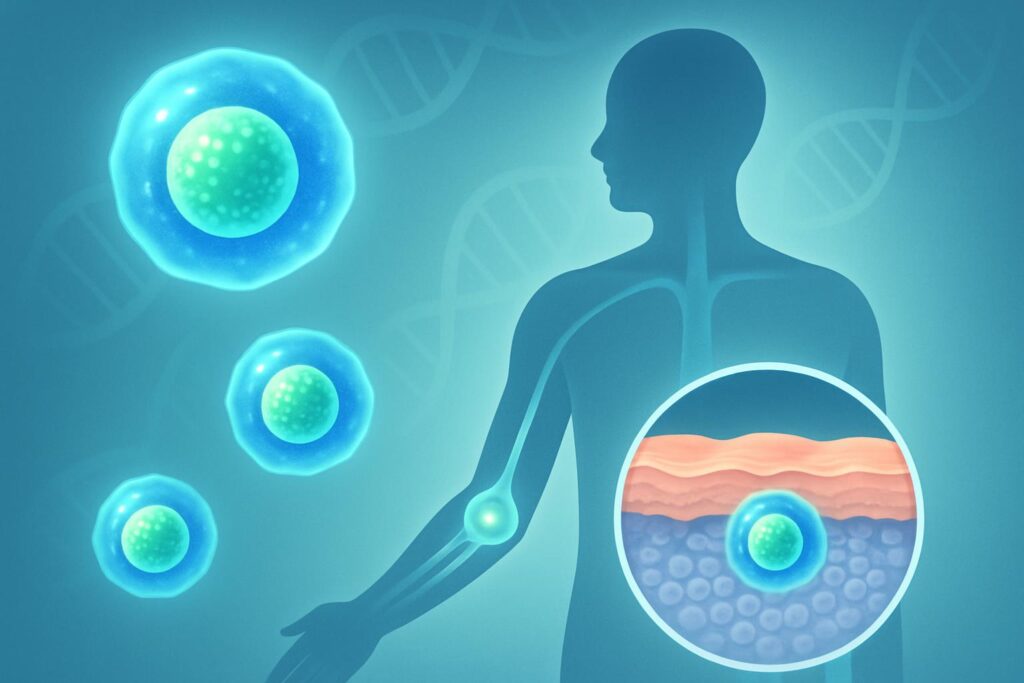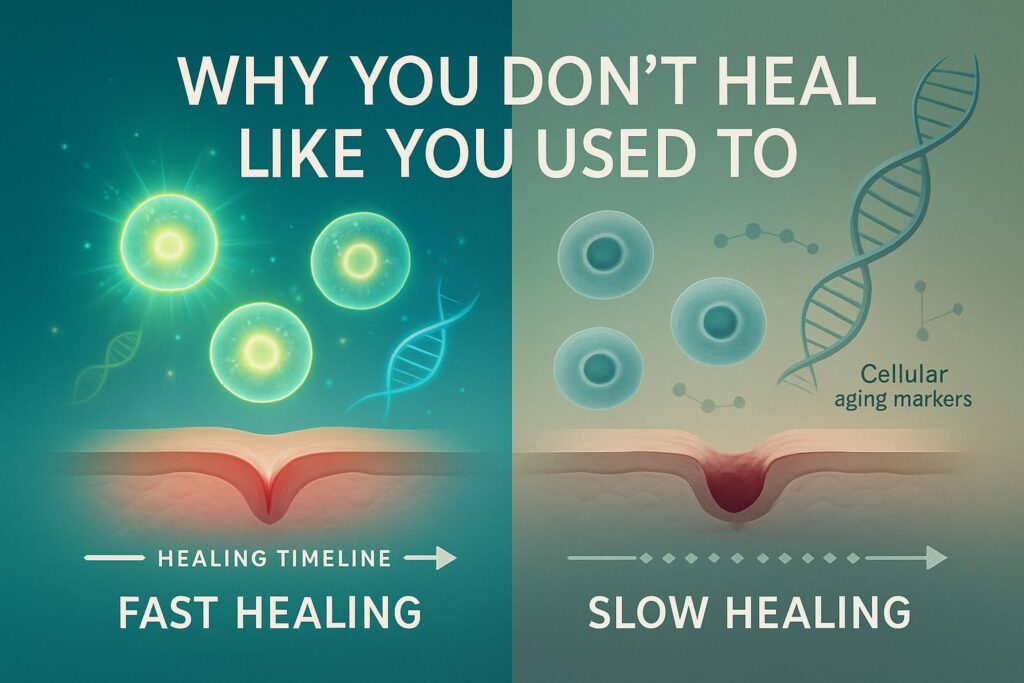Have you ever marveled at the power of the human body to heal itself?
Imagine harnessing that power and directing it precisely where it’s needed most. This isn’t a scene from a sci-fi movie but the real-world potential of stem cell therapy.
As we dive into the transformative world of stem cell treatments, it’s crucial to understand that the journey doesn’t end with the procedure itself. The true magic unfolds in the days, weeks, and months that follow, where aftercare plays a pivotal role in maximizing benefits and ensuring lasting success.
Understanding Stem Cell Therapy
Basics of Stem Cell Therapy
Stem cell therapy is akin to giving the body a “reset” button for healing. Imagine your body as a complex machine that’s capable of repairing itself, but sometimes it needs the right kind of “spare parts” to fix more serious damage.
Stem cells are these versatile spare parts. They can become many different types of cells and have the unique ability to find and repair damaged tissues.
This therapy is used to treat a wide range of diseases, from blood disorders like leukemia (through hematopoietic stem cell transplantation) to repairing damaged tissues in conditions such as osteoarthritis. The beauty of stem cells lies in their potential to not only replace damaged cells but also to promote healing and reduce inflammation.
How Stem Cell Therapy Works
The process starts with the collection of stem cells. Depending on the condition, these might be harvested from the patient’s own body (autologous transplantation) or from a donor (allogeneic transplantation). These cells might come from bone marrow, adipose tissue, or even umbilical cord blood.
Once collected, stem cells are processed and then administered back into the patient’s body, where they embark on a journey to the damaged area. Like construction workers rushing to a site, these cells begin repairing and rebuilding damaged tissues. This is where the magic happens—but the efficacy of this process can be significantly enhanced by proper aftercare.

The Role of Aftercare in Stem Cell Therapy
Overview of Aftercare Importance
The period following stem cell transplantation is critical. Just as a seed needs water, sunlight, and nutrients to grow, transplanted stem cells require optimal conditions to flourish. Aftercare is about creating these conditions, ensuring the new cells not only survive but thrive.
Proper aftercare can significantly enhance recovery and improve outcomes. It’s about avoiding complications, monitoring for adverse reactions, and supporting the body’s natural healing processes. This comprehensive approach helps to maximize the benefits of the therapy, turning potential into progress.
Goals of Stem Cell Therapy Aftercare
Aftercare aims to achieve several key objectives:
- Enhancing the Healing Process: This includes everything from managing pain and inflammation to supporting cell proliferation and integration.
- Preventing Complications: By monitoring and managing potential risks, we can prevent complications that might diminish the effectiveness of the therapy.
- Monitoring for Adverse Reactions: Close observation helps in early detection of any adverse reactions, ensuring timely interventions.
Components of Effective Stem Cell Therapy Aftercare
Immediate Post-Therapy Care
The first few hours and days after stem cell therapy are crucial. Patients may experience a range of symptoms, from mild discomfort at the injection site to fatigue. Managing these symptoms is vital, not just for comfort but to ensure the best environment for the stem cells to begin their work.
Long-Term Aftercare Strategies
As the days turn into weeks and months, aftercare shifts towards supporting long-term health and vitality. This includes:
- Lifestyle Modifications: Healthy habits can support the body’s healing processes. This means balanced nutrition, adequate sleep, and stress management.
- Nutrition and Supplements: Certain nutrients can support stem cell function. Omega-3 fatty acids, antioxidants, and specific vitamins may enhance the body’s ability to heal and regenerate.
- Physical Therapy and Exercise: Guided physical activity can support recovery, improve circulation, and enhance the overall success of the therapy.
Follow-Up and Monitoring
Regular follow-ups with healthcare providers are essential. These appointments allow for monitoring the integration and function of the stem cells, adjusting aftercare strategies as needed, and ensuring the patient’s overall well-being.
Aftercare is not a one-size-fits-all approach. It must be tailored to each individual’s needs, taking into account the type of stem cell therapy, the condition being treated, and the patient’s overall health. With the right aftercare, the promise of stem cell therapy—to significantly improve patients’ lives—becomes a tangible reality.
This detailed approach to aftercare is the bridge between the potential of stem cell therapy and the achievement of optimal health outcomes. As we continue to explore the components and strategies of effective aftercare, remember: the journey to recovery is a marathon, not a sprint. Patience, persistence, and informed care are key to unlocking the full potential of stem cells in healing and regeneration.
Addressing Challenges in Stem Cell Therapy Aftercare
Navigating the post-treatment landscape can sometimes feel like steering through a storm. Challenges are part of the journey, but with the right strategies, they can be effectively managed or even prevented.
Common Post-Therapy Complications and Management
Despite the advanced nature of stem cell therapies, complications can arise. These might include infections, reactions at the injection site, or inflammation. Imagine these complications as weeds in a garden; just as weeds can hinder the growth of plants, complications can impede the effectiveness of the therapy. Early detection and management are akin to pulling out these weeds before they spread, ensuring a healthy environment for the stem cells to thrive.
Management strategies include:
- Regular monitoring for signs of infection and prompt treatment.
- Managing inflammation through medication and lifestyle changes.
- Patient education on signs to watch for and when to seek medical attention.
Emotional and Psychological Support
The psychological aspect of recovery is like the soil’s quality in our garden analogy. Just as soil quality can affect plant growth, a patient’s emotional and mental state can influence their physical recovery. Support systems, whether they consist of family, friends, or support groups, provide the necessary nutrients for emotional well-being.
Counseling and therapy can also play a significant role, helping patients navigate the emotional ups and downs that might accompany their recovery journey. This multidimensional approach ensures that the patient is supported not just physically but emotionally and mentally, creating a holistic environment conducive to healing.
Case Studies and Success Stories
Nothing illustrates the importance and impact of aftercare more vividly than real-life examples. Let’s consider the case of John Doe (a fictional representation), who underwent stem cell therapy for a chronic knee injury. John’s aftercare plan included targeted physical therapy, a nutrition plan rich in anti-inflammatory foods, and regular follow-up appointments to monitor his progress.
Three months into his aftercare program, John reported a significant reduction in pain and improved mobility. His success story underscores the critical role of aftercare in enhancing recovery and improving outcomes. Through John’s journey, we learn that while the therapy itself is foundational, the aftercare program acts as the catalyst that propels patients toward their recovery goals.
Future Directions in Stem Cell Therapy and Aftercare
The frontier of stem cell therapy is ever-expanding, with research unlocking new potentials and applications. As the science advances, so too does the approach to aftercare, evolving to support the latest treatments and technologies.
Emerging Trends and Research
Innovations in cellular therapy and genetic engineering promise to enhance the precision and effectiveness of stem cell therapies. As these therapies become more complex, aftercare strategies must adapt to address the unique needs of patients undergoing these cutting-edge treatments.
Innovations in Aftercare Practices
The future of aftercare lies in personalization. Advances in technology and data analytics will enable healthcare providers to tailor aftercare programs to the individual’s specific needs, optimizing recovery and outcomes. This could include wearable technology to monitor vital signs and progress, as well as AI-driven platforms to adjust aftercare plans in real-time.
Staying Informed
For patients and caregivers, staying informed about the latest developments in stem cell therapy and aftercare is crucial. Engaging with reputable sources and participating in patient forums can help individuals make informed decisions about their care.
Conclusion
The journey through stem cell therapy is one of hope and possibility. Yet, it’s the aftercare that truly shapes the path to recovery and wellness. By understanding and embracing the components of effective aftercare, patients can enhance their healing process, mitigate risks, and move closer to their health goals.
As we look to the future, the potential of stem cells to heal and regenerate is boundless. With ongoing advancements in therapy and aftercare, we stand on the cusp of a new era in medicine—one where the full promise of stem cell therapy is realized, transforming lives and offering new beginnings.
Remember, the path to recovery is a partnership between patient and healthcare provider, with aftercare as the cornerstone of success. Together, we can navigate the complexities of post-treatment care, ensuring that every patient has the support they need to flourish and regain their health.
FAQ
Q: What is stem cell-based therapy?
A: Stem cell-based therapy is a treatment approach that uses stem cells to promote the repair, regeneration, or replacement of damaged or diseased cells, tissues, or organs in the body. Stem cells are undifferentiated cells that have the potential to develop into various cell types in the body.
Q: What is a stem cell transplant?
A: A stem cell transplant, also known as stem-cell transplantation, is a medical procedure in which stem cells are transplanted or infused into a patient’s body to replace or repair damaged bone marrow or to introduce healthy stem cells for the treatment of certain diseases or conditions.
Q: How does stem cell therapy improve outcomes in older adults?
A: Stem cell therapy has shown promise in improving outcomes in older adults undergoing stem cell transplants. It can enhance the engraftment of hematopoietic stem cells and promote the regeneration of healthy blood cells. It also has the potential to mitigate the risk factors for poor outcomes in this patient population.
Q: What are the different types of stem cells used in therapy?
A: There are various types of stem cells used in therapy, including hematopoietic stem cells (found in bone marrow and blood), mesenchymal stem cells (found in bone marrow, umbilical cord, and other tissues), induced pluripotent stem cells (generated from adult cells), and wharton’s jelly-derived mesenchymal stem cells (found in the umbilical cord).
Q: What is a randomized control trial in the context of stem cell-based therapy?
A: A randomized control trial is a research study design that compares the outcomes of a group of participants who receive a specific intervention (such as stem cell therapy) with the outcomes of a control group that does not receive the intervention. This design helps to determine the efficacy and safety of the intervention.
Q: How can stem cell therapy enhance outcomes in patients undergoing allogeneic stem cell transplantation?
A: Stem cell therapy can enhance outcomes in patients undergoing allogeneic stem cell transplantation by improving engraftment of the transplanted cells, reducing complications, and promoting the regeneration of healthy blood cells. It can also mitigate the risk factors associated with poor outcomes in this patient population.
Q: What are the main benefits of using stem cell therapy after a marrow transplant?
A: The main benefits of using stem cell therapy after a marrow transplant include improved engraftment of hematopoietic stem cells, accelerated recovery of the immune system, enhanced regeneration of healthy blood cells, and reduced risk of complications such as graft-versus-host disease.



